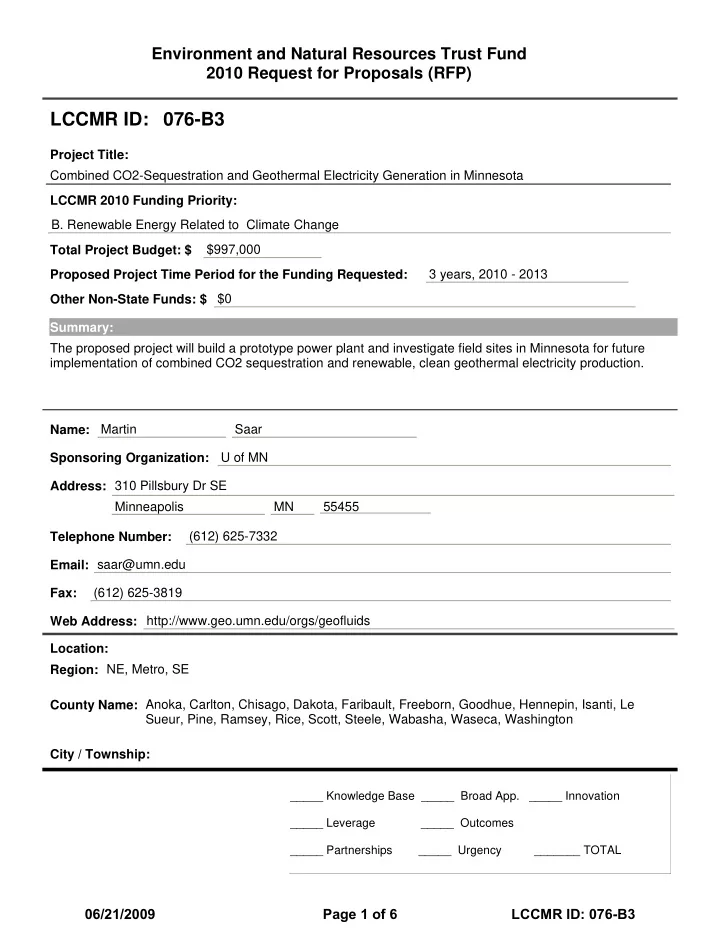

Environment and Natural Resources Trust Fund 2010 Request for Proposals (RFP) LCCMR ID: 076-B3 Project Title: Combined CO2-Sequestration and Geothermal Electricity Generation in Minnesota LCCMR 2010 Funding Priority: B. Renewable Energy Related to Climate Change Total Project Budget: $ $997,000 Proposed Project Time Period for the Funding Requested: 3 years, 2010 - 2013 Other Non-State Funds: $ $0 Summary: The proposed project will build a prototype power plant and investigate field sites in Minnesota for future implementation of combined CO2 sequestration and renewable, clean geothermal electricity production. Name: Martin Saar U of MN Sponsoring Organization: 310 Pillsbury Dr SE Address: Minneapolis MN 55455 (612) 625-7332 Telephone Number: saar@umn.edu Email: (612) 625-3819 Fax: http://www.geo.umn.edu/orgs/geofluids Web Address: Location: Region: NE, Metro, SE County Name: Anoka, Carlton, Chisago, Dakota, Faribault, Freeborn, Goodhue, Hennepin, Isanti, Le Sueur, Pine, Ramsey, Rice, Scott, Steele, Wabasha, Waseca, Washington City / Township: _____ Knowledge Base _____ Broad App. _____ Innovation _____ Leverage _____ Outcomes _____ Partnerships _____ Urgency _______ TOTAL 06/21/2009 Page 1 of 6 LCCMR ID: 076-B3
Main Proposal PROJECT TITLE: Combined CO 2 -sequestration and geothermal electricity generation in Minnesota and worldwide (funding priority: B. Renewable Energy Related to Climate Change) PROJECT STATEMENT: A revolutionary concept, that will not only address global warming by sequestering carbon dioxide (CO 2 ) but also provide renewable energy, is being developed by a research team at the University of Minnesota (UMN): Combining CO 2 sequestration with geothermal electricity generation. Here we propose to address two critical aspects of the concept: 1) construction and testing of a prototype power plant and 2) characterization of field sites in Minnesota for a future pilot plant system. Geothermal energy is a clean, renewable, and consistent energy source that has the capability to provide much of the nation’s and world’s electric power and space heating needs. Geothermal power plants are scalable to meet local or large-scale energy requirements and can supply base-load power or power to help meet peak demands. Three conditions must be met to use geothermal heat for electricity production: 1) Subsurface temperatures and geothermal heat flow rates need to be sufficiently high; 2) Large amounts of geothermally heated fluid (a liquid or gas, often water) must be present; 3) The subsurface geothermal reservoir must have sufficiently high porosity and permeability to allow easy flow and heating of the (liquid or gaseous) working fluid. Minnesota and most regions worldwide have low geothermal heat flow rates compared to geologically active regions such as the western US, traditionally excluding them from utilizing geothermal heat as a renewable energy alternative to fossil fuels. However, MN’s heat flow rates are likely underestimated (see concurrent LCCMR proposal by Hauck). Accurate measurements of subsurface temperatures and heat flow rates are thus critical to evaluate the state’s potential for geothermal electricity production, no matter what working fluid is used. CO 2 , however, has advantages over water as a geothermal working fluid: 1) The thermal properties of CO 2 allow lower temperatures, and thus shallower depths, to be used for geothermal electricity production. Power plant drilling and operation costs are reduced when shallower geologic units can be utilized as geothermal reservoirs. Thus, employing CO 2 could make geothermal electricity production economical in MN, which was not previously the case. 2) Water resources are often protected or needed for consumption/irrigation and thus unavailable for geothermal electricity production. Conversely, society needs to dispose the greenhouse gas, CO . 2 2 does not freeze at 32 o 3) CO F, improving power plant efficiency during Minnesota winters. In a combined CO 2 sequestration (i.e., permanent storage) and geothermal energy production system, CO 2 from a fossil fuel power plant or industry (e.g., ethanol plant) is injected into deep geologic traps (Figure 1). A fraction of the injected and geothermally heated CO 2 is brought back to the surface to drive a turbine and electricity generator, before being returned to the subsurface. The heat is replenished by the Earth’s natural heat flow, while the CO 2 is trapped within a geologic structure at great depth (0.6 to 3 miles). In this request, we propose to study two key aspects of the concept: 1) Design, construction, and testing of a prototype power plant utilizing waste heat from a UMN steam plant as a temporary substitute for deep geothermal heating of CO 2 . 2) Characterization of field sites in Minnesota to determine their CO storage and geothermal 2 heating potential for a later, separately funded, larger-scale pilot plant system in the field. Initial research is supported ($600,000) by the Initiative for Renewable Energy and the Environment (IREE) and a provisional patent (both by Saar et al., 2009). Here, we propose to expand on IREE funding, which is used to explore plant design alternatives and theoretically examine geothermal reservoirs. As part of the IREE study, we will also determine the economic feasibility of the proposed system and place the system into a policy framework relevant to MN. However, IREE funds do not cover implementation of a prototype power plant or CO 2 trap characterization of specific field sites in MN, which are critical and will require several years of study. Simultaneous investigation of both research avenues (results 1 and 2) would ensure the most rapid progress toward implementing a geothermal power plant in MN. 06/21/2009 Page 2 of 6 LCCMR ID: 076-B3
Recommend
More recommend